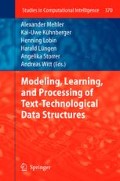Abstract
To compensate for the common inability of people with lexical production impairments to access and express intended concepts, we make use of models of human semantic memory that build on the notion of semantic similarity and relatedness. Such models, constructed on evidence gained from psycholinguistic experiments, form the basis of a large lexical database, WordNet. We augment WordNet with many additional links among words and concepts that are semantically related. Making this densely connected semantic network available to people with anomic aphasia through assistive technologies should enable them to navigate among related words and concepts and retrieve the words that they intend to express.
Access this chapter
Tax calculation will be finalised at checkout
Purchases are for personal use only
Preview
Unable to display preview. Download preview PDF.
References
Allen, M., McGrenere, J., Purves, B.: The design and field evaluation of phototalk: a digital image communication application for people. In: Assets 2007: Proceedings of the 9th International ACM SIGACCESS Conference on Computers and Accessibility, pp. 187–194. ACM, New York (2007), http://doi.acm.org/10.1145/1296843.1296876
Amazoncom, Inc., Amazon mechanical turk (2010), https://www.mturk.com (last accessed December 8, 2010)
Beukelman, D.R., Mirenda, P.: Augmentative and alternative Communication: Management of Severe Communication Disorders in Children and Adults. Brookes Publishing Company, Leiden (1998)
Boyd-Graber, J., Fellbaum, C., Osherson, D., Schapire, R.: Adding dense, weighted, connections to WordNet. In: Sojka, P., Choi, K.S., Fellbaum, C., Vossen, P. (eds.) Proc. Global WordNet Conference 2006, Global WordNet Association, Masaryk University in Brno, Brno, Czech Republic, pp. 29–35 (2006)
Boyd-Graber, J.L., Nikolova, S.S., Moffatt, K.A., Kin, K.C., Lee, J.Y., Mackey, L.W., Tremaine, M.M., Klawe, M.M.: Participatory design with proxies: Developing a desktop-PDA system to support people with aphasia. In: Proc. CHI 2006, pp. 151–160. ACM Press, New York (2006), doi: http://doi.acm.org/10.1145/1124772.1124797
Carmien, S.: MAPS: PDA scaffolding for independence for persons with cognitive impairments. In: Human-Computer Interaction Consortium (2002)
Collins, A.M., Loftus, E.F.: A spreading-activation theory of semantic processing. Psychological Review 82(6), 407–428 (1975), http://psycnet.apa.org/index.cfm?fa=search.displayRecord&uid=1976-03421-001
Daeman, E., Dadlani, P., Du, J., Li, Y., Erik-Paker, P., Martens, J., Ruyter, B.D.: Designing a free style, indirect, and interactive storytelling application for people with aphasia. In: INTERACT, pp. 221–234 (2007)
Dynavox, M.-J.: Dynavox, http://www.dynavoxtech.com/ (last accessed Dec 08, 2010)
Fellbaum, C.: A semantic network of English verbs. In: Fellbaum, C. (ed.) WordNet: An Electronic Lexical Database. MIT Press, Cambridge (1998)
Haigh, K., Kiff, L., Ho, G.: The Independent LifeStyle AssistantTM (I.L.S.A.): Lessons Learned. Assistive Technology 18, 87–106 (2006)
Jiang, J.J., Conrath, D.W.: Semantic similarity based on corpus statistics and lexical taxonomy. In: Proceedings on International Conference on Research in Computational Linguistics, Taiwan (1997)
Levinson, R.: PEAT: The planning and execution assistant and trainer. Journal of Head Trauma Rehabilitation 12(2), 769–775 (1997)
Lingraphicare Inc. Lingraphica, http://www.aphasia.com/ (last accessed December 8, 2010)
Miller, G.A.: Nouns in WordNet: A lexical inheritance system. International Journal of Lexicography 3(4), 245–264 (1990), http://ijl.oxfordjournals.org/cgi/reprint/3/4/245.pdf ; doi: 10.1093/ijl/3.4.245
Moffatt, K., McGrenere, J., Purves, B., Klawe, M.: The participatory design of a sound and image enhanced daily planner for people with aphasia. In: Proc. CHI 2004, pp. 407–414. ACM Press, New York (2004), doi: http://doi.acm.org/10.1145/985692.985744
Moss, H., Older, L.: Birkbeck Word Association Norms. Psychology Press, San Diego (1996)
Pollack, M.E., Brown, L., Colbry, D., McCarthy, C.E., Orosz, C., Peintner, B., Ramakrishnan, S., Tsamardinos, I.: Autominder: An intelligent cognitive orthotic system for people with memory impairment. Robotics and Autonomous Systems 44(3-4), 273–282 (2003)
van de Sandt-Koenderman, M.M., Wiegers, J., Hardy, P.: A computerised communication aid for people with aphasia. Disability Rehabilitation 27(9), 529–533 (2005)
Schapire, R.E.: The boosting approach to machine learning: An overview. In: Denison, D.D., Hansen, M.H., Holmes, C., Mallick, B., Yu, B. (eds.) Nonlinear Estimation and Classification. Springer, Heidelberg (2003)
O’Connor, S.R., Jurafsky D, Ng A (2008), Cheap and fast—but is it good? evaluating non-expert annotations for natural language tasks. Proceedings of EMNLP 2008, http://aclweb.org/anthology-new/D/D08/D08-1027.pdf
Swinney, D.: Lexical access during sentence comprehension: (Re)consideration of context effects. Journal of Verbal Learning and Verbal Behavior 18, 645–659 (1979)
The National Aphasia Association Aphasia: The facts, http://www.aphasia.org (last accessed December 8, 2010)
University of Oxford, British National Corpus (2006), http://www.natcorp.ox.ac.uk/ , http://www.natcorp.ox.ac.uk/
Author information
Authors and Affiliations
Editor information
Editors and Affiliations
Rights and permissions
Copyright information
© 2011 Springer-Verlag Berlin Heidelberg
About this chapter
Cite this chapter
Nikolova, S., Boyd-Graber, J., Fellbaum, C. (2011). Collecting Semantic Similarity Ratings to Connect Concepts in Assistive Communication Tools. In: Mehler, A., Kühnberger, KU., Lobin, H., Lüngen, H., Storrer, A., Witt, A. (eds) Modeling, Learning, and Processing of Text Technological Data Structures. Studies in Computational Intelligence, vol 370. Springer, Berlin, Heidelberg. https://doi.org/10.1007/978-3-642-22613-7_5
Download citation
DOI: https://doi.org/10.1007/978-3-642-22613-7_5
Publisher Name: Springer, Berlin, Heidelberg
Print ISBN: 978-3-642-22612-0
Online ISBN: 978-3-642-22613-7
eBook Packages: EngineeringEngineering (R0)

